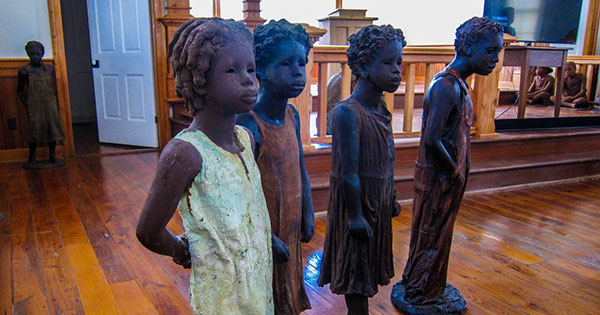
The Whitney Plantation, about an hour west of New Orleans, opened last winter as the first Louisiana plantation devoted solely to the interpretation of slavery. As such, it instantly rendered obsolete the hoop skirts, mint juleps, and paternalistic interpretations of slavery favored by some other plantation-based tourist destinations along the lower Mississippi.
The museum was the culmination of 15 years of planning and check-writing by a wealthy white New Orleans businessman named John Cummings, who reportedly spent more than $7 million in the doing. The result is part memorial park, part antebellum home tour, part art installation, all interpolated with a few standard museum elements.
Visiting the plantation is done via a 90-minute guided tour, which my wife and I paid $22 each for last May. We started by walking slowly through memorial gardens, with black granite slabs listing the names on the Louisiana registry of known slaves. I understand the reasoning for beginning with this, but it seemed this would be a better place to conclude and allow us to reflect at our own pace. As it was, our guide would call out, “OK, you guys!” every few minutes, and then direct us to another grove of slabs, say a few words, and then briefly turn us loose anew.
When we moved on to the rest of the grounds, the tour worked better. The rows of Spartan slave cabins (reconstructed) were discomfortingly evocative. The lone steel holding cell (it looked like an abandoned box car), where obstreperous slaves were broken in the brutal Louisiana summer, was chilling. The sight momentarily rendered our group of about a dozen (white) tourists silent, and we heard only the cicadas buzzing in the surrounding fields, the soundtrack always used in movies set in the south to convey oppressive heat. Entering the plantation house, we walked not up grand front steps but through the back door into the dim, low-ceilinged rooms beneath—as every slave would have done—which left a more enduring impression than any lecture.
Perhaps the most indelible image of the day, however, was that of a young man in our group wearing Nikes and cargo shorts taking photographs of himself at the memorials. Which left me pondering a question I hadn’t anticipated: When is it appropriate to use a selfie stick at a slavery exhibit?
The Whitney Plantation may be the most ambitious recent project drawing attention to the history of slavery in south Louisiana, but it’s not alone. This spring and summer the Historic New Orleans Collection put on a remarkable exhibit, coupled with a series of excellent lectures and other programming, called “Purchased Lives.” It took an unflinching look at New Orleans’s role in what might be called Slavery 2.0—the later domestic trade between the upper and lower south, which boomed in the years following the ban on the importation of slaves from overseas.
This came on the heels of a pair of extraordinary books published in 2014: The Half Has Never been Told by Edward E. Baptist and Empire of Cotton: A Global History by Sven Beckert. Both delved into New Orleans’s central role in brokering the human engines that powered white prosperity.
This past spring, a debate arose over plans for a new museum to be housed in a floating replica of a slave ship tied up on the New Orleans riverfront. Last May the city council signed off on a resolution offering support to the National Slave Ship Museum, which aims to convey the horrors of the Middle Passage. What’s odd is that New Orleans was never really a robust Middle Passage destination—it was a slave hub much later, with many slaves being marched south from the Carolinas or Virginia chained together in coffles of a hundred or more. These were equally inhumane, although more problematic to interpret for the tourist than a ship.
Slavery, though an uncomfortable topic for the descendants of those who profited, can’t be ignored. But also quite uncomfortable is watching the interpretation of slavery history bend toward “edutainment.” It’s unclear if the slave ship museum will offer sailings on the river, but I suspect financial needs will eventually include its being hired out for cocktail parties for visiting conventioneers.
The most troubling and powerful exhibit we saw at the Whitney Plantation was a grouping of ceramic heads by the sculptor Woodrow Nash set atop stainless steel rods in a small pond near the site’s visitors center. The installation was designed to commemorate an 1811 revolt by some 125 slaves, who rose up against their owners, killed a few, then began a march on New Orleans. Local soldiers soon routed the brigade of slaves, with many of them decapitated, their heads put on pikes along the river and in downtown New Orleans as a grisly warning for other slaves harboring ideas of rebellion.
Our guide pointed the work out from a distance before moving briskly on, although after the tour concluded, we went down by the water for a closer look. But a friend who toured the plantation just last month told me that the installation had been removed, although why or for how long was unclear. My email inquiry went unanswered, and my phone call received only a vague response, telling me that the exhibit will “probably” come back.

